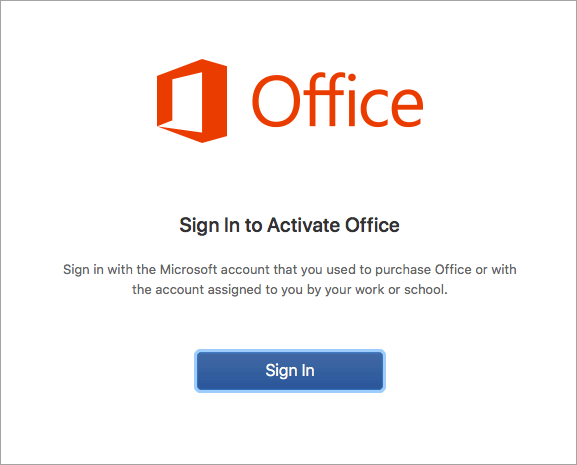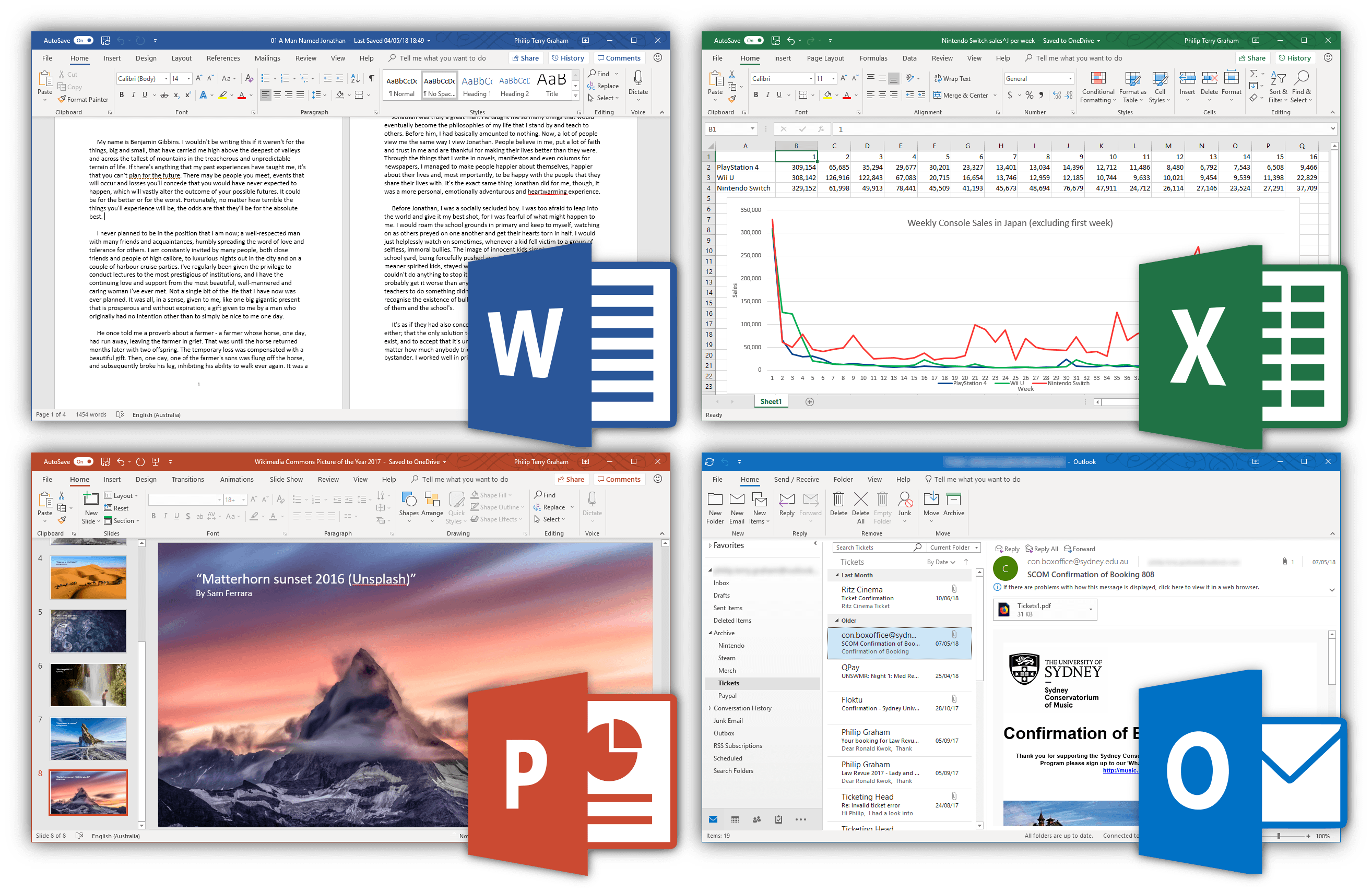For Office 365 (and Microsoft 365) customers, Office for Mac activates by contacting the Office Licensing Service on the internet. The Office Licensing Service keeps track of which users are licensed and how many computers they've installed Office on. Start quickly with the most recent versions of Word, Excel, PowerPoint, Outlook, OneNote and OneDrive —combining the familiarity of Office and the unique Mac features you love. Work online or offline, on your own or with others in real time—whatever works for what you’re doing.
When you buy a subscription to Microsoft 365 for business, you sign upfor a set of apps and services that you pay for on either a monthly oran annual basis. Amazon instant. The applications and services that you receive as partof your subscription depend on which product you purchased, such asMicrosoft 365 Apps for business or Microsoft 365 Business Standard. Youcan see what comes with each product on the Microsoft 365 for small and medium-sized businesses page.
When you buy a subscription, you specify the number of licenses that youneed, based on how many people you have in your organization. After youbuy a subscription, you create accounts for people in your organization,and then assign a license to each person. As your organizational needschange, you can buy more licenses to accommodate new people, or reassignlicenses to other users when someone leaves your organization.
If you have more than one subscription, you can assign licenses todifferent people for each subscription. For example, you can assign all of your users to all Microsoft 365 applications and services as partof a Microsoft 365 Business Standard subscription. You can also assign a subset of users to Visio Online through a separate Visio subscription.
How many devices can people install Office on?
If your subscription includes any of the following products, each person can install Office on up to five PCs or Mac, five tablets, and five phones.
- Microsoft 365 Apps for business
- Microsoft 365 Apps for enterprise
- Microsoft 365 Business Standard
- Microsoft 365 Business Premium
- Microsoft 365 A3
- Microsoft 365 A5
- Microsoft 365 E3
- Microsoft 365 E5
- Office 365 A1 Plus
- Office 365 A3
- Office 365 A5
- Office 365 E3
- Office 365 E5
What happens when you assign a license to someone?
The following table lists what automatically happens when you assign a license to someone:
| If the subscription has this service | This automatically happens |
|---|---|
| Exchange Online | A mailbox is created for that person. To learn about the SLA for this task to be completed, see 'Setting up..' messages in the Microsoft 365 admin center. |
| SharePoint Online | Edit permissions to the default SharePoint Online team site are assigned to that person. |
| Skype for Business Online | The person has access to the features associated with the license. |
| Microsoft 365 Apps for enterprise | The person can download Office apps on up to five Macs or PCs, five tablets, and five smartphones. |

Understand licenses for non-user mailboxes
You don't need to assign licenses to resource mailboxes, room mailboxes, and shared mailboxes, except when they are over their storage quota of 50 gigabytes (GB). For more about non-user mailboxes, see the following articles:
- Shared Mailboxes in Exchange Online for all other Microsoft 365 plans.
Who can assign licenses?
Different types of admins can work with licenses in different ways, depending on their roles. The following table lists the most common options. For a complete list of admin roles and privileges, see About admin roles.

| Admin role | Assign a license | Unassign a license | Buy more licenses | Delete an account |
|---|---|---|---|---|
| Billing admin | No | No | Yes | No |
| Global admin | Yes | Yes | Yes | Yes |
| License admin | Yes | Yes | No | No |
| Service Support admin | No | No | No | No |
| User admin | Yes | Yes | No | Yes |

Related content
Buy or remove licenses for your business subscription (article)
Assign licenses to users (article)
Unassign licenses from users (article)
Remove a license from a shared mailbox (article)
Applies to:Office for Mac, Office 2019 for Mac
To use Office for Mac in your organization, it needs to be activated. How you activate Office for Mac depends on whether your organization has an Office 365 (or Microsoft 365) plan or has a volume license agreement. But in both cases your users won't have to enter any product keys.
Note
If you're an Office user trying to activate a personal copy of Office for Mac, follow these instructions instead of reading this article.
Activate Office 365 versions of Office for Mac
If your organization has an Office 365 (or Microsoft 365) plan, make sure you assign each user a license for Office before you deploy Office for Mac to your users. If you don't assign a user a license, you can still deploy Office for Mac to that user, but the user won't be able to activate and use Office.
For Office 365 (and Microsoft 365) customers, Office for Mac activates by contacting the Office Licensing Service on the internet. The Office Licensing Service keeps track of which users are licensed and how many computers they've installed Office on.
After you deploy Office for Mac, your users are prompted to activate Office the first time they use it. Make sure users are connected to the internet when they activate Office.
Microsoft Office License Key For Mac
On the Sign in to Activate Office screen, users should select Sign In, and then enter their email address and password. After they sign in, users may see an alert asking for permission to access the Microsoft identity stored in their keychain. They should select Allow or Always Allow to continue.
While you can deploy Office for Mac for your users, your users need to sign in and activate Office for Mac for themselves. That's to ensure that the Office Licensing Service properly associates Office for Mac with the correct licensed user.

A program on the Mac, the Office365ServiceV2 daemon, runs once a day to check the user's subscription status. The computer must be connected to the internet to contact the Office Licensing Service. If the computer can't contact the Office Licensing Service after nine days, the user sees a warning message when working in an app.
If the computer can't contact the Office Licensing Service after 30 days, Office goes into reduced functionality mode. This means that the user can open, view, and print existing documents in an Office app, but can't create or edit documents. The user also sees a message in the app that most features aren't available. After the user connects to the internet and the subscription status is verified, all the features of Office are available again.
For each user that you've assigned a license to, you can deploy and activate Office for Mac on up to five Macs for the user. If you need to provide Office for Mac on a sixth computer for a user, you need to deactivate an existing installation first. Deactivating an installation doesn't remove Office for Mac from the computer. Instead, the installation goes into reduced functionality mode.
Users can sign into the Office 365 portal to deactivate an existing installation by going to My account > Install status > Manage installs. Or, you can deactivate an installation as an Office 365 administrator. Sign into the Office 365 portal, go to the admin center, and then go to Users > Active Users. Select the user, and then choose Edit for the Office installs property of the user.
Activate volume licensed versions of Office for Mac
Microsoft Office License Removal For Mac
To activate a volume licensed version of Office 2019 for Mac, use the Volume License (VL) Serializer. You can download the VL Serializer by signing into the Volume Licensing Service Center (VLSC). You run the VL Serializer on each computer. By doing this, your users won't see any activation prompts when they first open Office 2019 for Mac.
For more information, see Overview of the Volume License (VL) Serializer.
Related articles
